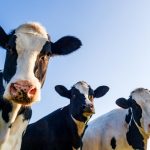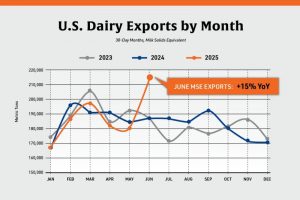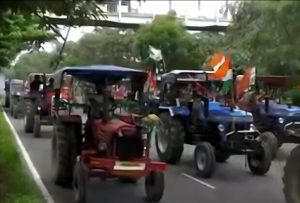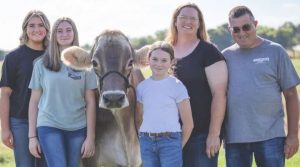
The Palladium-Times recently visited the Wilkholm Farm for an exclusive look at what it takes to run a local dairy farm, what goes on day-to-day in order to produce milk products and care for the cows.
Darren Adsit, a family member and farmhand on the Wilkholm Farm, guided The Palladium-Times on a recent tour. Adsit, who clearly has a passion for his work and a respect for the cattle, has been working on the farm for nearly 20 years.
The Wilkholm family farm, located at 105 La Robardiere Road in the town of Mexico, sits on a sprawling, more than 300-acre lot. The farm includes crop fields, cow stalls and massive modern farming machinery.
The Wilkholm Farm is host to two cow-inhabiting structures, the freestall — where the majority of the dairy cows are located — and a smaller, older barn acting as a house for the older and younger cows, according to Adsit, who noted the family’s cows are “probably larger than the state average”
“Our average is 1,700 to 1,800-pound cows,” Adsit said. “These are registered Holsteins, they’ve been bred for good size stature.”
The farm hosts roughly 300 cows and produces upward of 9,000 pounds, or 1,000 gallons, of milk daily.
On the farm, the family’s day consists of feeding the cows, maintaining the automated machines and helping the cows live the best life they can. The cow’s day is a revolving schedule of hydration, eating, relaxing, getting milked at an automated state-of-the-art milking machine, exercising and resting. Rest is a critical part of milk production, according to the family.
“They produce 70 percent of their milk when laying down,” Adsit said.
Milking cows today is “not like the old days,” according to Adsit, who said the family’s machine stimulates the cow’s utters and creates a natural feel for the animal to make an easy and effective way to get the milk.
“Our cattle step up on their own, get identified by their collars then the machine automatically milks them,” he said.
Staying in shape is part of a healthy lifestyle and for cows it’s no different, Adsit said. He said once a day, younger steeds run in a closed section of the barnyard while the cows in the freestall get their exercise from walking among the ranks of other cows and enjoy the sand under their hooves or instruments designed to allow the cattle to itch themselves.
In addition to those comforting amenities, a vital piece of equipment the farmers use is cow collars. The family uses them to read activity in the cattle’s stomach through a microphone on the collar, the walking rate through a pedometer, the cattle’s milk production level and more.
Adsit said the farm’s current system is vastly different then their traditional methods for monitoring the animals. Before the machines were installed, farmers visually and physically checked the cows and observed them to ensure they were properly digesting food.
“It was a very manual process, but this helps us check the cows faster then visual observations,” he said.
One recent obstacle the family has been working to overcome is the weather, and helping the livestock cope with the county’s diverse weather patterns.
Throughout the year, the county’s weather can cause the animals discomfort, but luckily for the cows at the Wilkinson Farm, the farmers are prepared for bitter cold or sweltering heat.
The National Weather Service reported high relative humidity throughout the county this week: including a 94 percent humidity rating Thursday, 97 percent on Wednesday, and a 94 percent Tuesday. Humidity ratings represent the amount of water vapor in the air expressed as a percentage needed to saturate air at the same temperature.
Several sprinkler systems, insulated roofs and massive adjustable window shades are located throughout the freestall and fans are placed strategically throughout the facility.
The Wilkholm Farm also produces corn and hay, in addition to dairy products.























